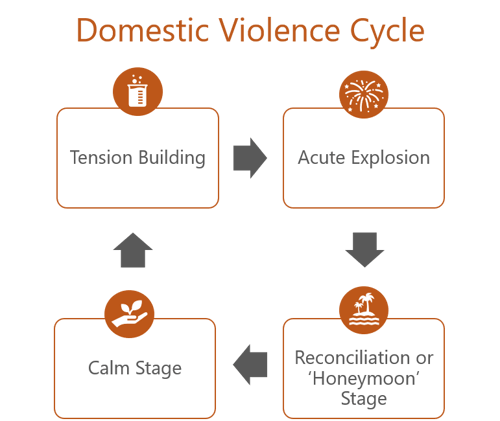Learn How Your EAP Can be Your first Step to end the cycle
" I don't think people realize how much strength it takes to pull your own self out of a poisonous situation with someone you love deeply. So if
you've done that today, or any day—I'm proud of you.
HORACIO JONES
Domestic violence incidents, which are defined as, “violent or aggressive behavior within the home, typically involving the violent abuse of a spouse or partner,” and includes intimate partner violence, child abuse, neglect and mistreatment, have been found to have spiked during the stay at home orders put into place by many states. Many victims of abuse have become trapped at home with no access to support or resources, as they are finding social services difficult to access and are
now unable to just leave the home and stay elsewhere.
A study that will be published in the American Journal of Criminal Justice next month states, “Reported incidents of domestic violence spiked during the beginning of shelter-at-home orders to stem the coronavirus pandemic (12.5%) and then gradually dropped off.” Due to the shelter in place orders, victims can be afraid to call for help as they are either constantly being monitored by their abusers, or have just given up, as the orders drag on and services are harder to come by.
Another explanation for the drop in domestic violence calls, is that much of the child abuse that is reported, comes from teachers, neighbors, family members and religious leaders. Without any contact with outside support systems, parents are not reporting on themselves or siblings who abuse siblings, so victims are left without help and caring adults to intervene.
If you suspect that a child is being abused, you should report it now and do not wait. It is probable that there will be a surge of calls once many shelter in place orders are lifted and supports services may be inundated and even overwhelmed with calls at that time.
What is Domestic Violence and What are the Types?
When we discuss domestic violence, people typically think of four main types: Emotional, Psychological, Verbal and Physical Abuse. However, this leaves out more sophisticated and harder to recognize behaviors such as Financial, Sexual, and Spiritual Abuse. Emotional Abuse can also be broken down to include mental and verbal abuse, and physical abuse can include threats and intimidation. These behaviors can be difficult to recognize, so let’s look at common explanations and examples.
Physical Abuse and Intimidation: Physical abuse is the type of abuse that most people recognize, it is the most “visible” and is defined as, “any intentional act causing injury or trauma to another person or animal by way of bodily contact.” This is true for abuse perpetrated on both adults and children, often inflicted in the
guise of discipline. Generally, this starts with threats and intimidation, which escalates to physical assault, including smacking, punching, kicking, shoving, throwing objects at victims or threatening with weapons.
Abusers may also try to physically restrain their victims from leaving, physically isolate them from friends and family, or threaten and intimidate victims by damaging property, injuring pets, threatening the safety of their
children, or showing weapons.
Emotional/Mental/Verbal and Psychological Abuse: This type of abuse
may not seem that damaging and is very often minimized. But truthfully,
the effects of this type of abuse are long lasting and incredibly damaging
to the victim. You can treat, mend, or even ‘prove’ a broken bone, for
example, but it can be very difficult to do the same with emotional abuse.
Mending a broken soul and psyche is very difficult and painful work that
can take years of counseling for many.

Abusers will attack their victims psychologically and demean them by calling them names, assaulting the victims’ character, or verbally attacking them in public in front of family, friends or strangers with the intention of breaking them down. Abusers often deny their actions, blame the victim and minimize victims’ complaints about their behavior. This gaslighting behavior makes victims question who they really are, the type of parent or spouse they are and even have them questioning their own reality - which often creates paranoid thinking and low self-esteem. Often abusers have cut off victims’ support systems by either bad-mouthing and belittling family and friends, or literally not allowing access. This frequently leaves the victim left without loving people to talk to about the abuse, to get support or to have a reality check on the abusive behaviors. Silence perpetuates abuse.
It is known that people who have experienced childhood trauma are highly prone to be victims of psychological, emotional and verbal abuse as adults and their tolerance for bad behavior is much higher than someone who has not experienced abuse. These behaviors can result in psychological trauma and often creates chronic anxiety, depression, post-traumatic stress disorder and suicidal thoughts. There is also a strong correlation between trauma and substance abuse.
Financial or Economic Abuse: This type of abuse is prevalent among female victims. Here, the abuser might prevent their partner from working, or force them to quit their existing job. Abusers may demand money from their partner and threaten or abuse them when their request is denied. Some abusers hide or remove
access to family income, or completely control all decisions surrounding income, during the relationship or during divorce/separation. All of these abusive behaviors can cause severe, long lasting financial impact on the victim.
Sexual Abuse: Defined as, “any undesired sexual activity, including unwanted sexual advances, forced exposure to pornography, or sexual encounters tied to emotional, physical, social, or spiritual abuse” and is another tactic used by the abuser to exert power and control over their partner. This abuse attacks the victims trust and combines sexual betrayal with physical and emotional abuse, and for some, causes spiritual harm due to the religious undertones regarding sexual responsibilities in marriage or a partnered relationship.
Spiritual Abuse: is when an abuser uses religion as a way to exert control and power over their victim, while inflicting many of the other above mentioned types of abuse, and then the abuser uses religious beliefs or customs as a way to justify their abusive behaviors. Spiritual abuse can be used to mock, embarrass, shame
and/or manipulate the victim, so they do not feel free to express or practice their spiritual beliefs, which can take away their source of strength and support needed to endure abuse.
Bringing it all together: Additional educational points regarding domestic violence to consider and remember are things like: early warning signs to look for in abusers, things to look for in others who may be experiencing abuse, and the stages we see in domestic violence.
Early warning signs are usually minor forms of selfcentered, controlling and jealous behaviors that escalate as time goes on. These are often justified as love and blamed on the victim as a “result” of their behaviors.
Symptoms in victims can range from the obvious unexplained physical injuries, to chronic abdominal pain, headaches, constant cancelling of plans, not allowing others in their home, a lot of unexplained sick days at work or school, or making excuses for the abusive behaviors of their partner.
The Domestic Violence Cycle confuses victims and keeps victims in relationships. Although people stay in abusive relationships for various reasons, there is usually a pattern of behaviors that keeps the victim around. These predictable stages include: Tension Building Stage, Acute Explosion, Reconciliation or ‘Honeymoon’
Stage, and the Calm Stage. While the first two stages are the build-up to the abuse and the abuse itself, the last two stages offer the victim time to “forgive and forget” enough to stay until the next explosion and the cycle continues.
YOU ARE NOT ALONE and there is help! Hotlines, support groups and shelters can offer emotional support, resources, safety planning, connect you to authorities, help with legal issues and personal protection orders, as well as shelter for victims of abuse and their children.
National Domestic Violence Hotline at 800.799.7233
National Parent Helpline at 855.427.2736
Crisis Text Line provides free, 24/7 support for those in crisis.
Text 741741 any time to connect with a crisis counselor, or visit crisistextline.org
If you are looking for something more local, or counseling-based support and resources option, please remember your employer provided Employee Assistance Program can be the first step in getting help. When an organization partners with Ulliance, the EAP provides free, short-term, solution focused counseling services to employees. The most important words to remember are – you are not alone.
Combining years of clinical experience and the formation of a meaningful partnership with an organization’s human resources department, Ulliance is among the best EAP providers and our experts can tailor recommendations for a variety of work\life circumstances.
The Ulliance EAP services can help employees and employers come closer to a state of total well-being.
To learn how we can help, give call us at 866.648.8326.
The Ulliance Employee Assistance Program can address the
following issues:
• Stress about work or job performance
• Crisis in the workplace
• Conflict resolution at work or in one’s personal life
• Marital or relationship problems
• Child or elder care concerns
• Financial worries
• Mental health problems
• Alcohol/substance abuse
• Grief
• Interpersonal conflicts
• AND MORE!


